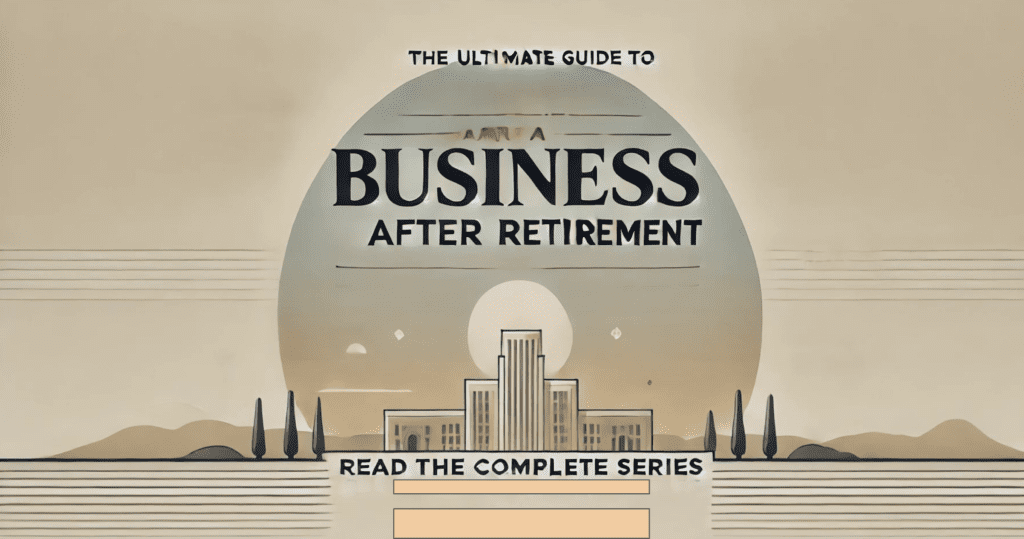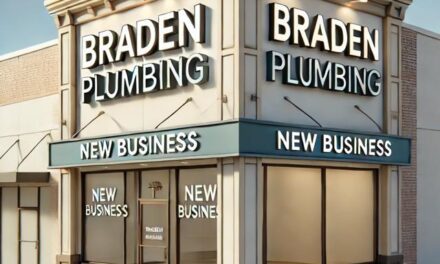Last updated on March 6th, 2025 at 07:11 pm
You are going to start a business after retirement. You have decided on the type of business and set goals. Now it’s time to create your business plan. Successful companies start with a solid plan to guide their efforts. Your plan should focus on your own schedule and coordinate with your retirement plan.
This article is the third in our series on “Starting a Business After Retirement”. Links at the end of this article will take you to other articles in this series. You will learn how to set up your own solid business plan that will take you to a profitable business. At the end of the article, you will find a button that will take you to the RetireCoast Interactive Business Plan Template.
There are a number of steps you need to take before you can create your solid business plan. The list below will help you prepare to create your plan. I suggest that you read the prior two articles which contain discussions about a business model and some of the decisions included in our list.
Before developing a business plan, there are several critical preparatory steps that lay the foundation for creating an effective and actionable plan.

Here’s a list of key things to consider and accomplish:
1. Self-Assessment and Vision
- Define your goals and objectives for the business.
- Assess your skills, experience, and resources.
- Clarify your personal mission and the business’s purpose.
2. Market Research
- Identify your target audience or customer base.
- Analyze market trends and demands.
- Research competitors to understand their strengths, weaknesses, and market position.
3. Validate Your Business Idea
- Conduct surveys or focus groups to gauge interest.
- Create a minimum viable product (MVP) or prototype if applicable.
- Gather feedback and refine your idea based on input.
4. Determine the Legal Structure
- Decide on the type of business entity (e.g., sole proprietorship, LLC, corporation).
- Research legal and regulatory requirements for your industry.
5. Financial Preparation
- Assess your startup costs and funding needs.
- Explore funding options (e.g., savings, investors, loans).
- Set up a preliminary budget for operations.
- Consider tax strategy
6. Build a Network
- Connect with mentors, advisors, or industry professionals.
- Join relevant business or trade associations.
- Establish relationships with potential partners or collaborators.
7. Develop a Value Proposition
- Clearly define what makes your product or service unique.
- Identify the problem you’re solving for your target customers.
8. Outline Your Business Model
- Determine how your business will generate revenue.
- Identify key activities, resources, and partners.
- Decide on pricing strategies and distribution channels.
9. Secure Necessary Resources
- Identify and obtain physical, intellectual, or technological resources.
- Evaluate and plan for necessary equipment, software, or tools.
10. Understand the Industry Landscape
- Research industry-specific challenges and opportunities.
- Stay informed about economic factors that could impact your business.
11. Define Your Brand
- Establish your business name and branding elements (logo, colors, tagline).
- Set up a basic online presence (e.g., domain name, social media handles).
12. Draft a Business Concept
- Write a concise summary of your business idea.
- Include the purpose, products or services, and target market.
Completing these steps will give you a clear understanding of your business landscape and ensure that you approach the creation of your business plan with well-informed, actionable insights.
Baby boomers with years of experience in business may not have created a business plan. There is some work involved to gather the information mentioned above and to actually get the information into an actionable document. I will be breaking down some of the list above for further clarification before we get into the actual business plan. Starting with expanding on item 12, Draft a Business Concept.
Drafting a business concept involves clearly and concisely defining your business idea, its purpose, and its value to your target audience. A strong business concept provides the foundation for your business plan and serves as a guide for your operations.
Frequently Asked Questions
Q1: Why do I need a business plan for my retirement business?
A business plan helps you outline your goals, strategies, financial needs, and potential challenges. It serves as a roadmap for success and is essential if you’re seeking funding from banks, investors, or grants.
Q2: What are the key sections of a business plan for a retiree entrepreneur?
A solid business plan includes:
– Executive Summary – Overview of the business idea
– Business Description – What problem it solves
– Market Research – Target audience and competitors
– Business Model – How you’ll generate revenue
– Marketing Plan – Strategies to attract customers
– Financial Plan – Budget, funding, and profit projections
Q3: How detailed should my business plan be?
It depends on your business size and funding needs. If you’re self-funding a small business, a simple 1-2 page plan may work. If you need a bank loan or investor funding, a more detailed plan (10+ pages) is ideal.
Q4: Do I need professional help to write my business plan?
Not necessarily. You can use business plan templates from the Small Business Administration (SBA) or online tools like LivePlan. However, if you’re seeking funding, hiring a business consultant may be beneficial.
Q5: What are the biggest mistakes retirees make when writing a business plan?
Common mistakes include:
– Skipping financial planning (underestimating startup costs)
– Ignoring market research (not knowing the target audience)
– Being too optimistic (overestimating sales and underestimating expenses)
– Lack of flexibility (not planning for market changes)
Here’s how to create a well-structured business concept:
1. Start with a Clear Vision
- Define the purpose: What problem does your business solve, and why does it matter?
- State your mission: What are you aiming to achieve with your business?
- Example: “Our mission is to provide affordable, eco-friendly cleaning products to households and businesses, reducing environmental impact without compromising effectiveness.”
2. Describe Your Product or Service
- Outline what your business will offer.
- Focus on unique features or benefits that set your product/service apart.
- Example: “We offer a subscription service for artisanal coffee, sourced from small, sustainable farms and delivered fresh to your doorstep.”
3. Identify the Target Market
- Define your ideal customers (age, location, income level, preferences).
- Highlight their needs or pain points and how your business addresses them.
- Example: “Our target audience is busy professionals aged 25–45 who value convenience and premium-quality coffee.”
4. Explain the Value Proposition
- Describe the unique value your business offers to customers.
- Show how it stands out from competitors.
- Example: “Unlike mass-produced coffee, our service ensures traceability, supports small-scale farmers, and provides an exceptional taste experience.”
5. Outline the Revenue Model
- Indicate how your business will make money (e.g., sales, subscriptions, licensing).
- Be clear about pricing and profit potential.
- Example: “Revenue will be generated through monthly subscriptions priced at $20, offering two deliveries of freshly roasted coffee beans per month.”
6. Highlight the Competitive Advantage
- Explain what gives your business an edge in the market.
- This could include proprietary technology, exceptional customer service, or exclusive partnerships.
- Example: “Our competitive advantage lies in our exclusive partnerships with local organic coffee farms and our commitment to carbon-neutral shipping.”
7. Address the Business Model
- Briefly explain how the business will operate.
- Include key activities, resources, and partnerships.
- Example: “We will source beans directly from ethical farms, roast them in-house, and handle fulfillment through a third-party logistics partner to ensure timely deliveries.”
8. Consider Scalability
- Indicate how your business can grow in the future.
- Highlight expansion opportunities, such as new markets or product lines.
- Example: “After establishing our subscription service, we plan to expand into retail by offering our products in grocery stores and cafes.”
9. Summarize in a Single Paragraph
- Combine all the elements into a concise, compelling paragraph.
- Example: “Our business, GreenScents Cleaning, provides affordable, eco-friendly cleaning products for environmentally conscious consumers. With a subscription model, customers receive biodegradable, non-toxic cleaning solutions tailored to their needs. Our products stand out for their superior cleaning power, sustainable sourcing, and plastic-free packaging. By partnering with local suppliers and using innovative refill stations, we aim to revolutionize how households maintain cleanliness while reducing waste.”
10. Test Your Concept
- Share your draft with trusted peers, mentors, or potential customers.
- Gather feedback to refine and clarify your concept.
This concise business concept can serve as the foundation for pitching your idea to stakeholders or building a detailed business plan. The good news is that if you have come this far, the next steps will be easier to put into the actual business plan.
Before I get into showing you an actual sample business plan, let’s go over the elements of a business plan. This exercise of developing a business plan is itself part of the journey small business owners go through to completely flush out their ideas.
Don’t worry about getting the business plan perfect. This is your document, you can and will make changes as you move forward. Hopefully, your business will help improve your retirement years. The business plan will give you a sense of purpose.
You may or may not have to present this plan to a bank for a Small Business Administration loan or to prospective partners. Regardless, it will hopefully keep you on track. Let’s get into the structure of a business plan:
Creating a business plan involves systematic steps that combine research, analysis, and strategic planning. A well-crafted plan not only guides your business operations but also communicates your vision to investors, partners, and stakeholders.

Here’s the best way to create a business plan:
1. Understand the Purpose of Your Business Plan
- Determine the plan’s primary use: securing funding, guiding operations, or strategizing growth.
- Tailor the content to your audience (investors, lenders, team members).
2. Gather Necessary Information
- Conduct thorough market research to understand industry trends, competitors, and target audiences.
- Collect financial data, such as startup costs, revenue projections, and pricing strategies.
- Review case studies or examples of successful business plans in your industry.
3. Use a Business Plan Template
- Choose a template for structure and guidance. Our free template is available by clicking here, others are available from platforms like SCORE, and SBA.
- Customize the template to fit your business specifics.
4. Structure Your Business Plan
A typical business plan includes these sections:
Executive Summary
- A concise overview of your business.
- Highlight key points: mission, product/service, market, and financial goals.
- Write this section last to summarize the full plan.
Business Description
- Explain what your business does and its purpose.
- Include your mission, vision, and values.
- Describe the legal structure (LLC, sole proprietorship, etc.) and business location.
Market Analysis
- Present research on your industry, target market, and competitors.
- Highlight market size, customer demographics, and trends.
- Use visuals like charts or graphs for clarity.
Organization and Management
- Outline your team structure and key personnel.
- Include bios of founders or executives.
- Define roles, responsibilities, and ownership structure.
Products or Services
- Describe what you’re offering and its unique value.
- Detail the product lifecycle, production process, or service delivery model.
- Highlight intellectual property or proprietary technology.
Marketing and Sales Strategy
- Explain how you will attract and retain customers.
- Detail pricing, promotion, distribution channels, and sales tactics.
Operational Plan
- Describe day-to-day operations, including suppliers, facilities, and technology.
- Include timelines for production, delivery, or milestones.
Financial Plan
- Include financial projections: income statement, cash flow statement, and balance sheet.
- Detail funding requirements and use of funds.
- Provide break-even analysis and profitability forecasts.
Appendix (Optional)
- Attach supporting documents, such as resumes, legal agreements, product images, or additional research.
5. Use SMART Goals
- Define objectives that are Specific, Measurable, Achievable, Relevant, and Time-bound.
- Example: “Increase online sales by 20% within six months through targeted social media campaigns.”
6. Make it Visually Appealing
- Use professional formatting, clear headings, and concise language.
- Incorporate visuals like charts, graphs, and infographics.
7. Review and Refine
- Proofread for errors and clarity.
- Share the draft with mentors, advisors, or peers for feedback.
- Refine based on constructive input.
8. Leverage Technology
- Use tools like Google Docs for collaboration, Canva for design, and Excel for financial modeling.
- Consider software like LivePlan or BizPlan for step-by-step guidance.
9. Stay Flexible
- Treat your business plan as a living document.
- Update it as your business evolves or as new opportunities arise.
10. Practice Your Pitch
- Be prepared to present your business plan to investors or stakeholders.
- Develop a concise pitch that complements your written plan.
Final Tip: Focus on Clarity and Realism
A great business plan is realistic, actionable, and clear. It demonstrates deep understanding, careful planning, and the potential for success.
Now let’s take a look at what a sample business plan looks like before we get into your actual plan. I have created a sample plan for “Visionary Consulting Group”. It will give you an idea of what is contained in an actual plan. Later we will provide you with a template that you can use to create a plan. If you think you need to present the plan to a third party, this would be an ideal time to think about the presentation.
As mentioned above, actually printing and assembling the plan is very important. Consider having a custom binder created for you with tabs and your name on the cover. The fact that you took time to do this is by itself an indication of your professionalism.
Remember the business plan is in part designed to impress a prospective lender or partner. Take a look at the sample plan below. It would look better when printed and assembled in a binder:
Business Plan for Visionary Consulting Group
Executive Summary
Business Name: Visionary Consulting Group
Mission Statement: To empower small and medium-sized businesses (SMBs) with strategic insights and innovative solutions that drive growth, streamline operations, and maximize profitability.
Products/Services: Visionary Consulting Group offers management consulting services, including business strategy development, process optimization, market analysis, and leadership training.
Target Market: SMBs in the technology, retail, and healthcare sectors.
Financial Highlights: Initial startup costs are projected at $50,000. Revenue in the first year is expected to reach $150,000, with a profit margin of 40%.
Business Description
Overview: Visionary Consulting Group is a management consulting firm focused on delivering tailored solutions to SMBs. Our expertise lies in helping businesses identify opportunities, overcome challenges, and achieve sustainable growth.
Legal Structure: Limited Liability Company (LLC).
Location: Headquarters in Austin, Texas, with plans to expand into remote consulting services nationwide.
Vision: To become a trusted partner for SMBs, renowned for excellence, reliability, and measurable results.
Market Analysis
Industry Overview: The management consulting industry in the U.S. is valued at over $250 billion and is expected to grow at a compound annual growth rate (CAGR) of 4.5% over the next five years. SMBs increasingly seek external expertise to navigate market complexities.
Target Market: SMBs with annual revenues between $1 million and $50 million.
- Demographics: Business owners aged 35-55.
- Geography: Initially focusing on businesses in Texas, expanding nationwide within two years.
Competitor Analysis: Key competitors include boutique consulting firms and larger firms like McKinsey and Deloitte targeting the upper-tier market. Visionary Consulting Group will differentiate by offering customized, affordable solutions tailored to SMBs.
Organization and Management
Ownership Structure: Sole proprietorship transitioning to an LLC.
Leadership:
- Founder & CEO: Sarah Thompson – 15 years of experience in management consulting, specializing in process optimization and strategy.
- Advisory Board: Includes experts in finance, marketing, and technology.
Key Team Members:
- Project Managers: Ensure timely delivery of consulting projects.
- Analysts: Conduct market research and data analysis.
- Administrative Staff: Manage client scheduling and billing.
Products and Services
Core Offerings:
- Business Strategy Development: Crafting customized strategies for growth and competitive advantage.
- Process Optimization: Streamlining operations to reduce costs and improve efficiency.
- Market Analysis: Researching market trends and consumer behaviors to inform decision-making.
- Leadership Training: Empowering managers and executives with the skills needed to lead effectively.
Unique Selling Proposition (USP): Affordable, highly customized consulting solutions delivered by a team with deep expertise and a passion for SMB success.
Marketing and Sales Strategy
Marketing Plan:
- Digital Marketing: Utilize SEO, content marketing, and social media advertising to attract leads.
- Networking: Attend local business events and industry conferences to build connections.
- Referrals: Develop a referral program offering discounts to existing clients who bring in new business.
Sales Strategy:
- Free initial consultation to assess client needs.
- Customized proposals highlighting specific ROI projections.
- Follow-up strategies via email and calls to convert leads.
Operational Plan
Daily Operations:
- Client consultations and project meetings.
- Deliverables creation, including reports and presentations.
- Administrative tasks, such as invoicing and scheduling.
Technology and Tools:
- Project management software (e.g., Trello, Asana).
- Data analytics tools (e.g., Tableau, Excel).
- CRM system for managing client relationships.
Location and Facilities:
- Office space in Austin, Texas, with remote work capabilities.
- Use of coworking spaces for client meetings as needed.
Financial Plan
Startup Costs:
- Legal and licensing fees: $5,000.
- Office setup: $10,000.
- Marketing: $15,000.
- Technology and tools: $10,000.
- Working capital: $10,000.
Revenue Projections:
- Year 1: $150,000.
- Year 2: $250,000.
- Year 3: $400,000.
Profit Margin: Expected to stabilize at 40% by Year 3.
Funding Requirements: $50,000 in initial funding from personal savings and a small business loan.
Appendix
- Founder’s Resume
- Sample Project Proposal
- Testimonials from Past Clients (if available)
What’s missing from this plan?
Note how simple the plan is when printed. You should add documents in your appendix to substantiate some of the data you are providing. For example, financial planning. If you need a financial advisor, consider working with a good CPA who can help you with the budget and tax issues.
You will need a budget. That budget should show each month of the first year and then budget for five years. We will give you an example at the end of this article then visit us to check out our article on budgets and the financial side of starting your new business.
By the way, I have not addressed the elephant in the room “fear of failure”. One of every five new businesses fail within the first year. Here are some statistics:
According to the U.S. Bureau of Labor Statistics (BLS) and various business studies, approximately 20% of new businesses fail within the first year. This means that about one in five startups do not survive their initial 12 months.
Here’s additional context about business failure rates:
- Within 2 years: Around 30% of businesses fail.
- Within 5 years: About 50% of businesses fail.
- Within 10 years: Roughly 65% of businesses fail.
These statistics emphasize the importance of thorough planning, adequate funding, and adaptability to increase the chances of success.
Ok, we got that out of the way. Now let’s get into why these businesses fail. Here is a list of the top 10 reasons why businesses fail:
1. Lack of Market Demand
- The product or service does not solve a significant problem or meet a real need.
- Insufficient market research leads to offering something no one wants.
2. Insufficient Capital
- Running out of money due to underestimating costs or overestimating revenue.
- Difficulty securing funding or managing cash flow effectively.
3. Poor Business Model
- Lack of a clear plan for how the business will generate revenue and achieve profitability.
- Reliance on unsustainable pricing or unscalable operations.
4. Ineffective Marketing
- Inability to reach the target audience or differentiate from competitors.
- Neglecting online presence or failing to adapt to changing marketing trends.
5. Leadership and Management Issues
- Lack of experience or expertise in managing a business.
- Poor decision-making, inability to delegate, or conflicts among leadership.
6. Competition
- Underestimating competitors or failing to adapt to a crowded market.
- Inability to offer unique value or compete on price and quality.
7. Poor Financial Management
- Inadequate tracking of expenses and revenues.
- Mismanaging budgets, failing to secure emergency funds, or neglecting tax obligations.
- Not paying taxes when due.
8. Operational Inefficiencies
- Disorganized workflows or inadequate technology.
- Overhiring, underperformance of employees, or lack of training.
9. Legal and Regulatory Challenges
- Failure to comply with local, state, or federal regulations.
- Inadequate understanding of licensing, permits, or industry-specific laws.
10. Burnout
- Entrepreneurs become overwhelmed or lose motivation due to long hours and stress.
- Neglecting work-life balance leads to poor decision-making and reduced productivity.
Addressing these common pitfalls involves careful planning, adaptability, and leveraging expert advice. Regularly assessing your business operations and market environment can help prevent many of these issues. Now that we know why new businesses have failed, let’s get into an even greater reason. Many lacked a business plan.
The following will help clarify that:
Studies and surveys consistently show that the lack of a business plan is a significant factor in new business failures, though precise percentages can vary depending on the source. Here’s what the research reveals:
- Entrepreneurship.org Study:
- About 30% of businesses that fail in their first two years lack a business plan.
- Businesses with a plan are more likely to succeed, as the plan provides a roadmap for growth, financial management, and decision-making.
- SBA (Small Business Administration) Insight:
- SBA reports indicate that a business plan can double the likelihood of success.
- Lack of planning contributes to common issues like insufficient funding, poor financial management, and failure to understand market needs.
- Palo Alto Software Study:
- A survey found that over 70% of successful small businesses attribute their survival to having a comprehensive business plan.
- Conversely, businesses that failed often cited the lack of a plan as a critical mistake.

A business without a plan is at greater risk of failing
While exact percentages may differ by region and industry, it is widely recognized that businesses without a plan face significantly higher risks of failure. A solid business plan improves clarity, resource allocation, and adaptability, which are essential for long-term survival.
This is how we address your new career. New entrepreneurs need a solid business plan as we have been discussing. Based upon the study above, 70% surveyed indicated their business plan was a key reason for their business success. Your life experience is where it all starts and using that experience to make good decisions based on a plan should lead to financial stability for your new business.
Go over the top ten reasons for business failure while you are creating your business plan. If it’s for a consulting business as an example, consider the top ten and how they will not apply to your plan. You will do the exact opposite. Take number one. Lack of market demand.
Your research indicates there is a market demand
If you have done your research, you will know that there is market demand for our offering. Number two is insufficient capital. It’s a good idea to start your business with sufficient financial resources to guarantee success.
Be very careful with item 2. Do not invest all of your retirement funds into your new business, keep in mind that should your business fail, you still need income to survive. Always consider using other people’s money if you need substantial capital.
Your financial security should be top of mind. Some business ventures can drain capital so be careful at the very start of the planning process. Weight your risks. Do not jeopardize your retirement account entirely on your new enterprise. Retirement savings do not grow on trees.
All of that said, I have started several businesses after retirement. I used some of my retirement funds to start them and they have been successful and are contributing to my personal finances. I have been my own boss before. Many years ago, I started a company and eventually sold it to a Fortune 500 firm.
I stayed on and managed it for several years, part of my exit strategy. So, having been there and done that, I encourage your efforts to do the same.
Business plan template
Now let’s get into the reason for this article, the actual interactive business plan template. The link below will take you to our interactive business plan template. The template is designed for you to enter information that will become your business plan when you are finished.
Click the button below which will take you to the business plan template on this site.
Starting a new Business in Retirement Series

Choose one of our articles below. The series is still being written. We expect to publish about once per week, check back, or sign up to receive notice about new articles.
Starting a new business after retirement, consider the Mississippi Gulf Coast. According to Swoop Funding, Mississippi is the #4 best state to start a business.
Click on the button below to see all of our articles on Starting a Business After Retirement
Please sign up to receive notices of new articles published by RetireCoast.com Leave comments about this and any other articles.
Discover more from RetireCoast.com
Subscribe to get the latest posts sent to your email.









